sensor TOYOTA SEQUOIA 2020 (in English) Service Manual
[x] Cancel search | Manufacturer: TOYOTA, Model Year: 2020, Model line: SEQUOIA, Model: TOYOTA SEQUOIA 2020Pages: 588, PDF Size: 12.33 MB
Page 293 of 588
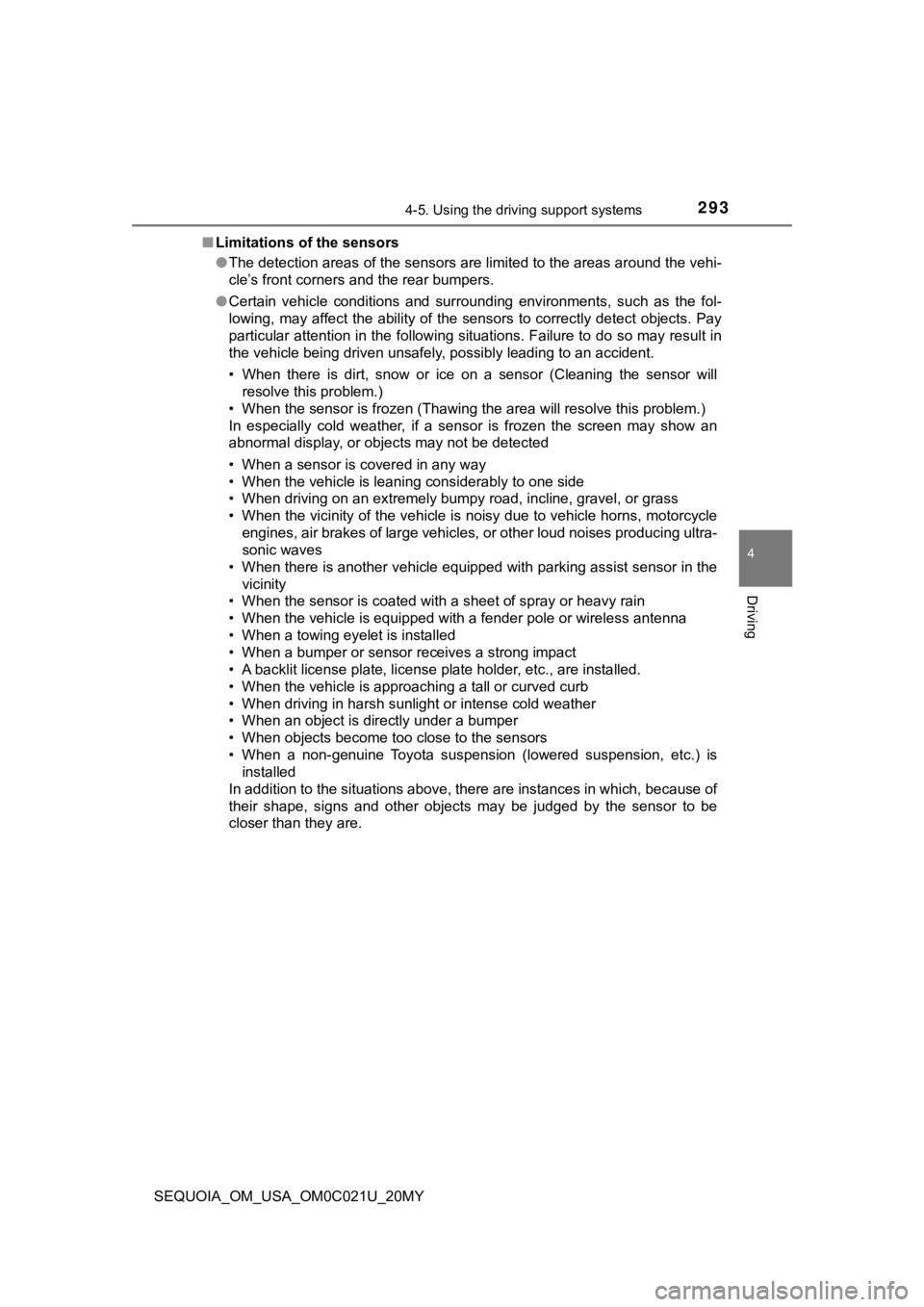
2934-5. Using the driving support systems
4
Driving
SEQUOIA_OM_USA_OM0C021U_20MY■
Limitations of the sensors
●The detection areas of the sensors are limited to the areas aro und the vehi-
cle’s front corners and the rear bumpers.
● Certain vehicle conditions and surrounding environments, such a s the fol-
lowing, may affect the ability of the sensors to correctly dete ct objects. Pay
particular attention in the following situations. Failure to do so may result in
the vehicle being driven unsafely, possibly leading to an accident.
• When there is dirt, snow or ice on a sensor (Cleaning the sens or will
resolve this problem.)
• When the sensor is frozen (Thawing the area will resolve this problem.)
In especially cold weather, if a sensor is frozen the screen ma y show an
abnormal display, or objects may not be detected
• When a sensor is covered in any way
• When the vehicle is leaning considerably to one side
• When driving on an extremely bumpy road, incline, gravel, or g rass
• When the vicinity of the vehicle is noisy due to vehicle horns , motorcycle
engines, air brakes of large vehicles, or other loud noises pro ducing ultra-
sonic waves
• When there is another vehicle equipped with parking assist sen sor in the
vicinity
• When the sensor is coated with a sheet of spray or heavy rain
• When the vehicle is equipped with a fender pole or wireless an tenna
• When a towing eyelet is installed
• When a bumper or sensor receives a strong impact
• A backlit license plate, license plate holder, etc., are insta lled.
• When the vehicle is approaching a tall or curved curb
• When driving in harsh sunlight or intense cold weather
• When an object is directly under a bumper
• When objects become too close to the sensors
• When a non-genuine Toyota suspension (lowered suspension, etc. ) is
installed
In addition to the situations above, there are instances in which, because of
their shape, signs and other objects may be judged by the senso r to be
closer than they are.
Page 294 of 588

2944-5. Using the driving support systems
SEQUOIA_OM_USA_OM0C021U_20MY●
The shape of an object may prevent the sensor from detecting it. Pay partic-
ular attention to the following:
• Wires, fences, ropes, etc.
• Cotton, snow and other materials that absorb sound waves
• Sharply-angled objects
• Low objects
• Tall objects with upper sections projecting outwards in the direction of
your vehicle
• People, animals and other moving objects
• People wearing certain types of clothing
● The following situations may occur when using the intuitive parking assist.
• Depending on the shape of the object and other factors, the de tection dis-
tance may be shortened, or detection may not be possible.
• Objects may not be detected if they are too close to a sensor.
• There will be a short delay between the detection of an object and display
of the detection. Even at slow speeds, there is a possibility t hat the object
will come within a sensor’s detection area before the display i s shown
and a warning beep sounds.
• Thin posts or objects lower than a sensor may not be detected when
approached, even if they have been detected once.
• It might be difficult to hear beeps due to the volume of the a udio system
or air flow noise of the air conditioning system.
■ If a message is displayed on th e multi-information display
P. 477
■ Customization that can be configured at Toyota dealer
Settings (e.g. buzzer volume) can be changed.
(Customizable features P. 544)
■ Certification (Canada only)
This ISM device complies with Canadian ICES-001.
Page 295 of 588
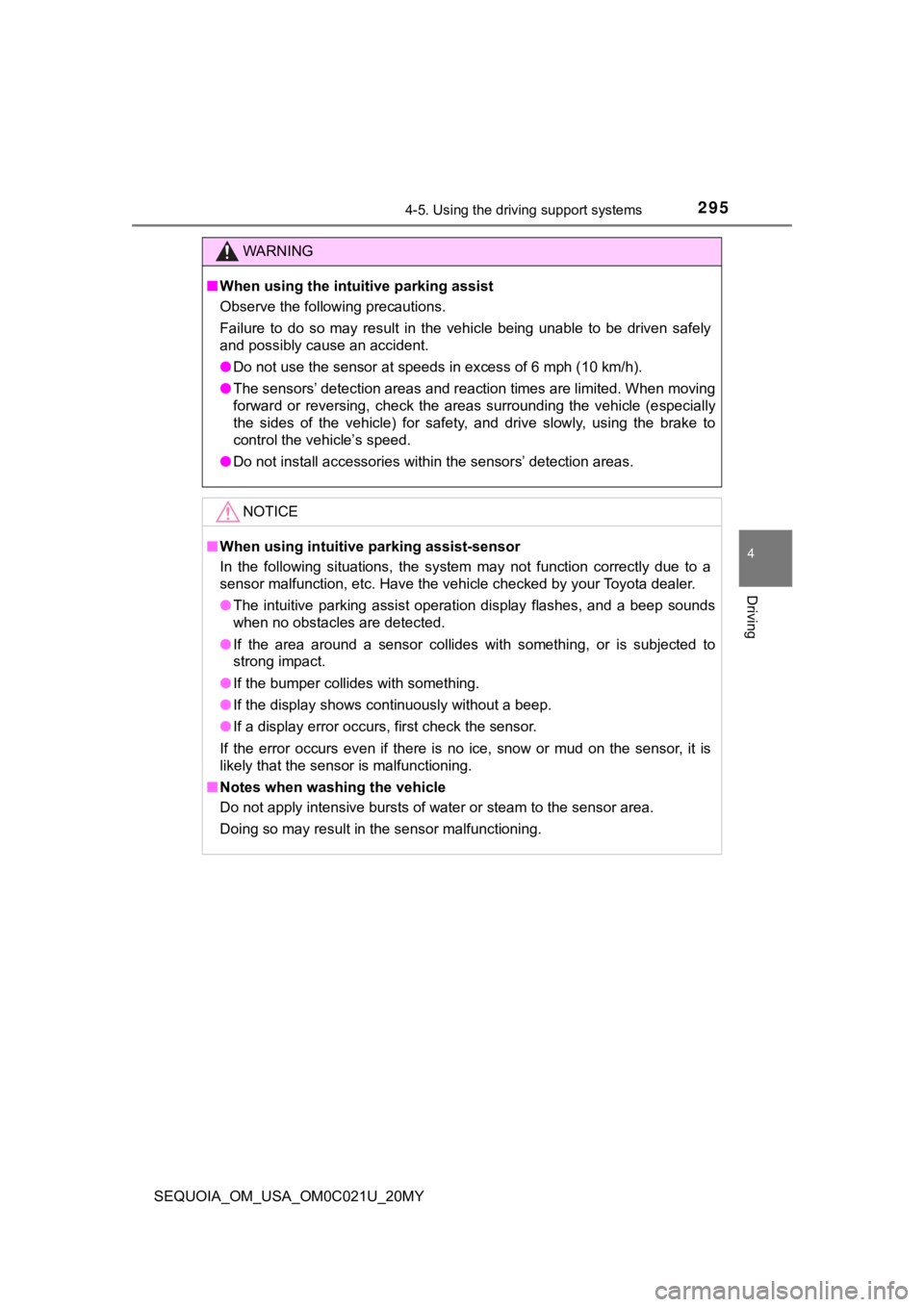
2954-5. Using the driving support systems
4
Driving
SEQUOIA_OM_USA_OM0C021U_20MY
WARNING
■When using the intuitive parking assist
Observe the following precautions.
Failure to do so may result in the vehicle being unable to be d riven safely
and possibly cause an accident.
● Do not use the sensor at speeds in excess of 6 mph (10 km/h).
● The sensors’ detection areas and reaction times are limited. When moving
forward or reversing, check the areas surrounding the vehicle ( especially
the sides of the vehicle) for safety, and drive slowly, using t he brake to
control the vehicle’s speed.
● Do not install accessories within the sensors’ detection areas.
NOTICE
■When using intuitive parking assist-sensor
In the following situations, the system may not function correctly due to a
sensor malfunction, etc. Have the vehicle checked by your Toyot a dealer.
● The intuitive parking assist operation display flashes, and a beep sounds
when no obstacles are detected.
● If the area around a sensor collides with something, or is subjected to
strong impact.
● If the bumper collides with something.
● If the display shows continuously without a beep.
● If a display error occurs, first check the sensor.
If the error occurs even if there is no ice, snow or mud on the sensor, it is
likely that the sensor is malfunctioning.
■ Notes when washing the vehicle
Do not apply intensive bursts of water or steam to the sensor a rea.
Doing so may result in the sensor malfunctioning.
Page 296 of 588
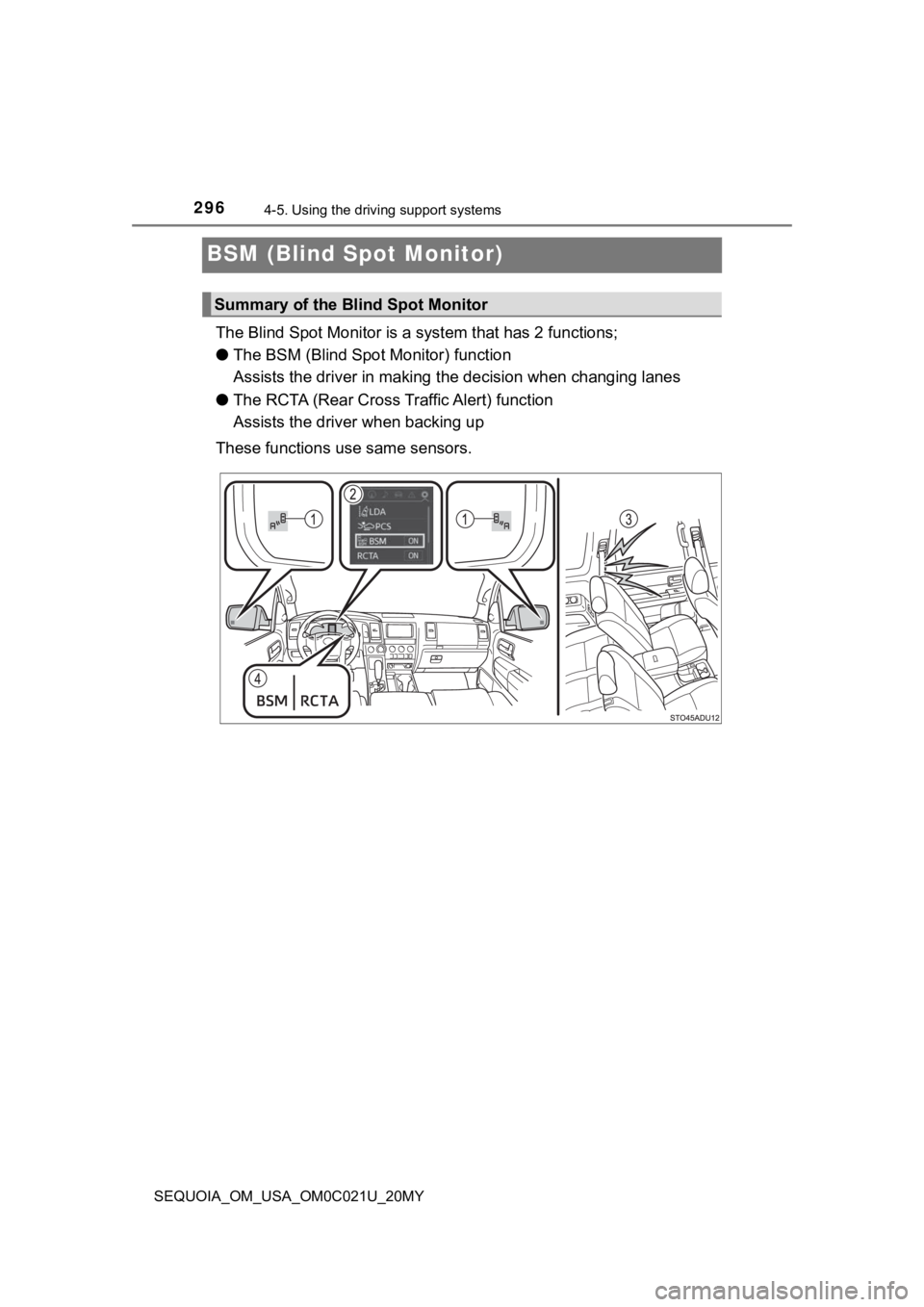
2964-5. Using the driving support systems
SEQUOIA_OM_USA_OM0C021U_20MY
BSM (Blind Spot Monitor)
The Blind Spot Monitor is a system that has 2 functions;
● The BSM (Blind Spot Monitor) function
Assists the driver in making t he decision when changing lanes
● The RCTA (Rear Cross Tra ffic Alert) function
Assists the driver when backing up
These functions use same sensors.
Summary of the Blind Spot Monitor
Page 298 of 588
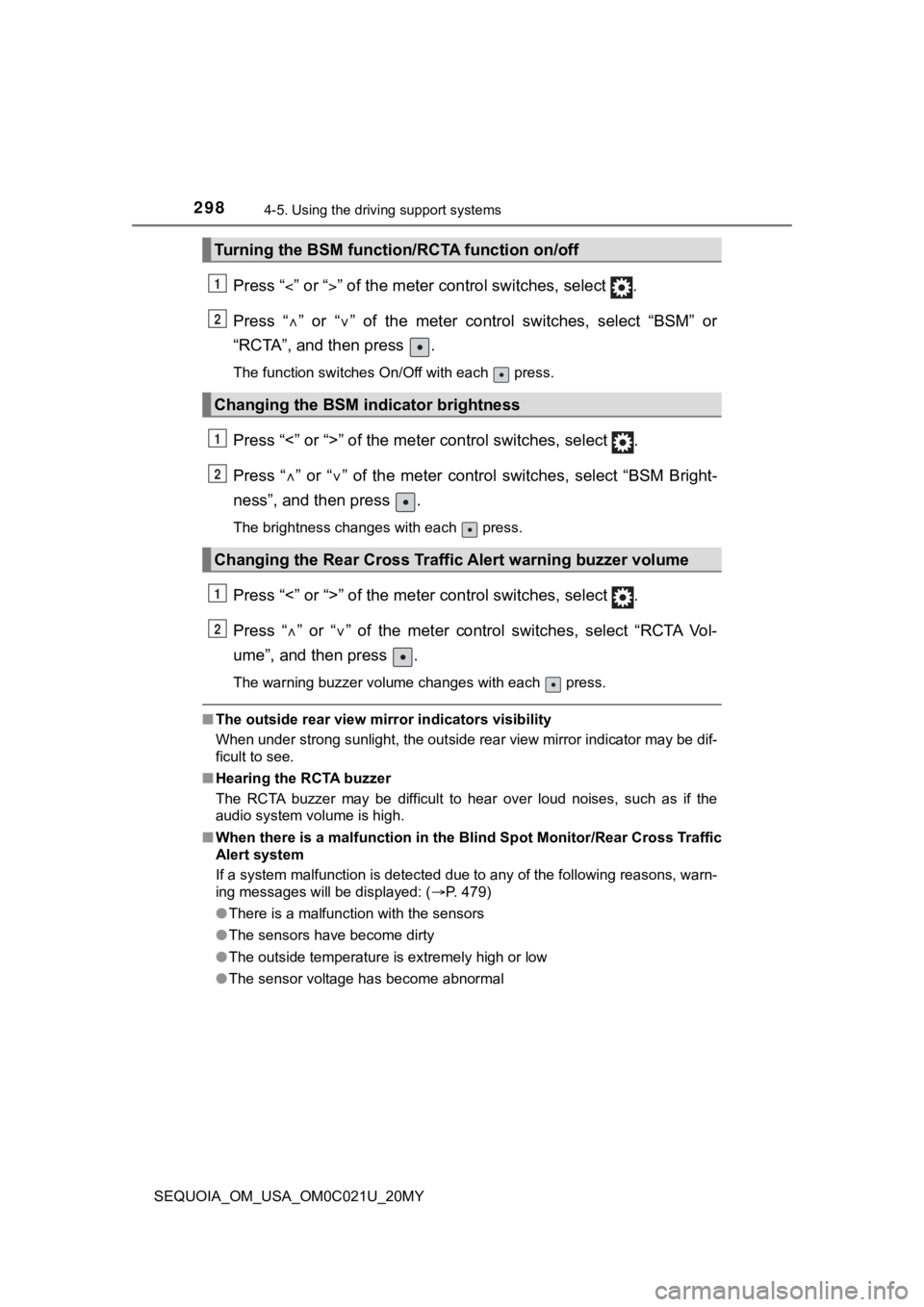
2984-5. Using the driving support systems
SEQUOIA_OM_USA_OM0C021U_20MY
Press “” or “” of the meter control switches, select .
Press “ ” or “ ” of the meter control switches, select “BSM” or
“RCTA”, and then press .
The function switches On/Off with each press.
Press “<” or “>” of the meter control switches, select .
Press “ ” or “ ” of the meter control switches, select “BSM Bright-
ness”, and then press .
The brightness changes with each press.
Press “<” or “>” of the meter control switches, select .
Press “ ” or “ ” of the meter control switches, select “RCTA Vol-
ume”, and then press .
The warning buzzer volume changes with each press.
■ The outside rear view mirror indicators visibility
When under strong sunlight, the outside rear view mirror indica tor may be dif-
ficult to see.
■ Hearing the RCTA buzzer
The RCTA buzzer may be difficult to hear over loud noises, such as if the
audio system volume is high.
■ When there is a malfunction in t he Blind Spot Monitor/Rear Cros s Traffic
Alert system
If a system malfunction is detected due to any of the following reasons, warn-
ing messages will be displayed: ( P. 479)
● There is a malfunction with the sensors
● The sensors have become dirty
● The outside temperature is extremely high or low
● The sensor voltage has become abnormal
Turning the BSM function/RCTA function on/off
Changing the BSM indicator brightness
Changing the Rear Cross Traffic Alert warning buzzer volume
1
2
1
2
1
2
Page 300 of 588
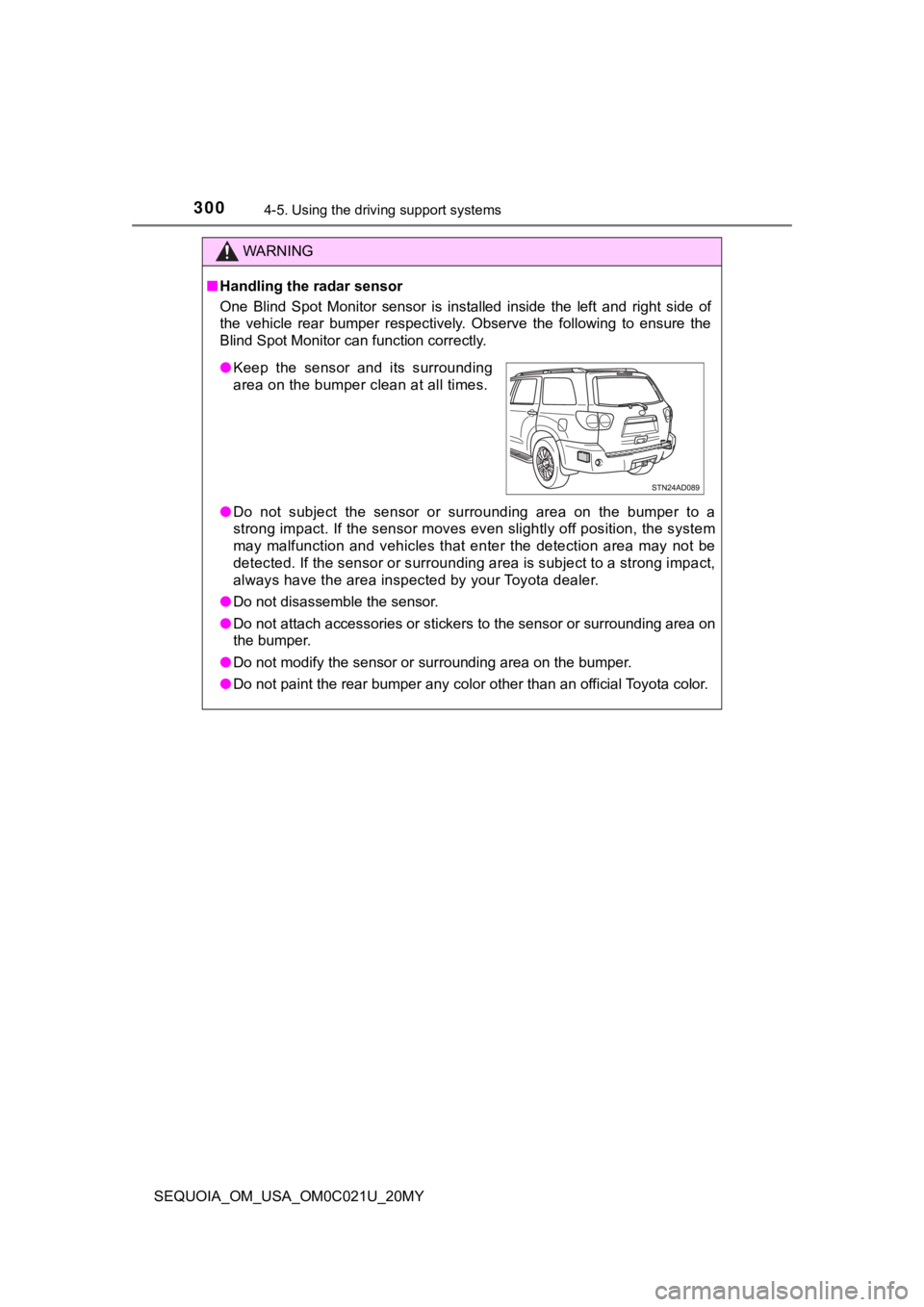
3004-5. Using the driving support systems
SEQUOIA_OM_USA_OM0C021U_20MY
WARNING
■Handling the radar sensor
One Blind Spot Monitor sensor is installed inside the left and right side of
the vehicle rear bumper respectively. Observe the following to ensure the
Blind Spot Monitor can function correctly.
● Do not subject the sensor or surrounding area on the bumper to a
strong impact. If the sensor moves even slightly off position, the system
may malfunction and vehicles that enter the detection area may not be
detected. If the sensor or surrounding area is subject to a str ong impact,
always have the area inspected by your Toyota dealer.
● Do not disassemble the sensor.
● Do not attach accessories or stickers to the sensor or surround ing area on
the bumper.
● Do not modify the sensor or surrounding area on the bumper.
● Do not paint the rear bumper any color other than an official Toyota color.
●Keep the sensor and its surrounding
area on the bumper clean at all times.
Page 301 of 588
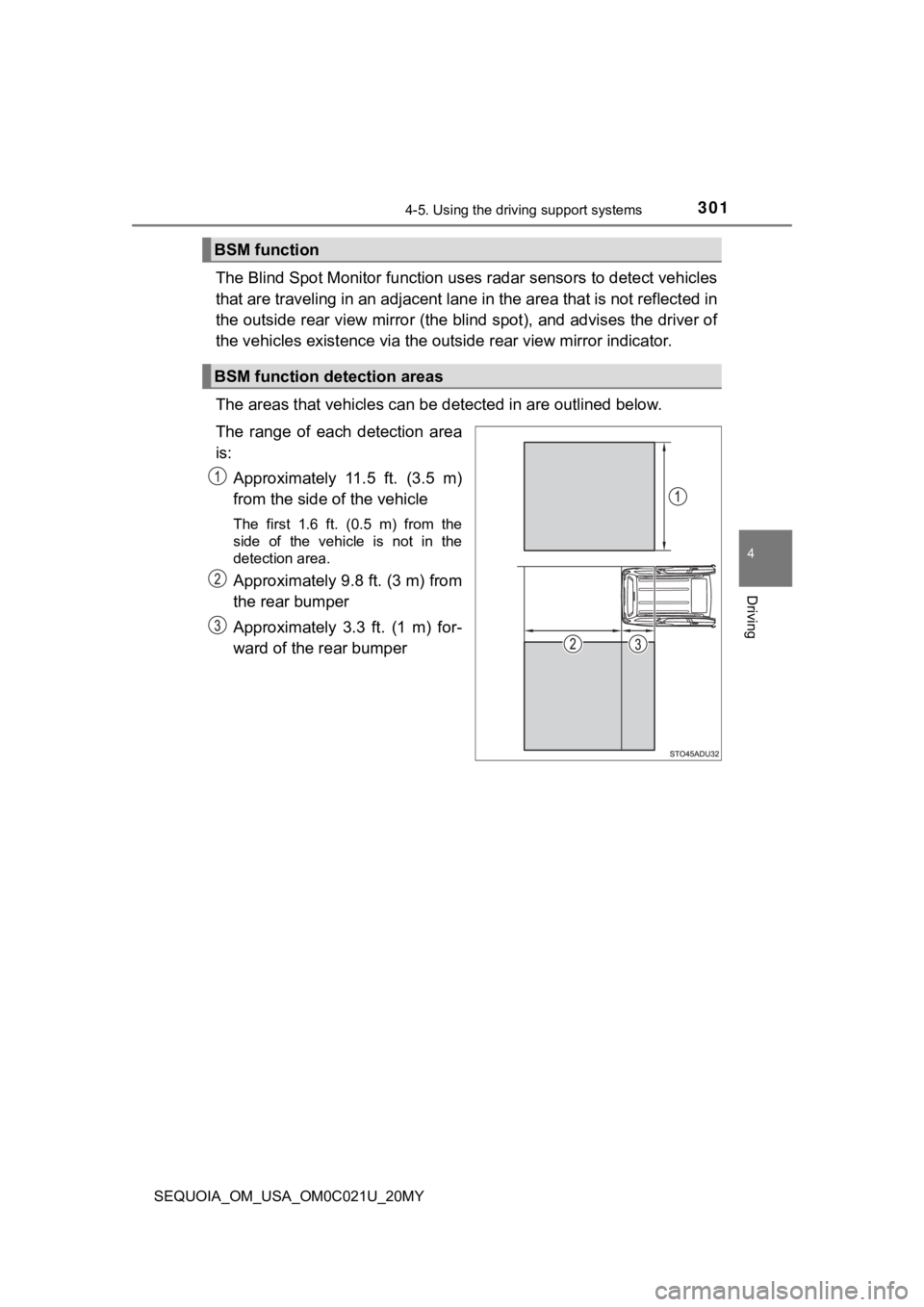
3014-5. Using the driving support systems
4
Driving
SEQUOIA_OM_USA_OM0C021U_20MY
The Blind Spot Monitor function uses radar sensors to detect vehicles
that are traveling in an adjacent lane in the area that is not reflected in
the outside rear view mirror (the blind spot), and advises the driver of
the vehicles existence via the outside rear view mirror indicat or.
The areas that vehicles can be detected in are outlined below.
The range of each detection area
is: Approximately 11.5 ft. (3.5 m)
from the side of the vehicle
The first 1.6 ft. (0.5 m) from the
side of the vehicle is not in the
detection area.
Approximately 9.8 ft. (3 m) from
the rear bumper
Approximately 3.3 ft. (1 m) for-
ward of the rear bumper
BSM function
BSM function detection areas
Page 304 of 588
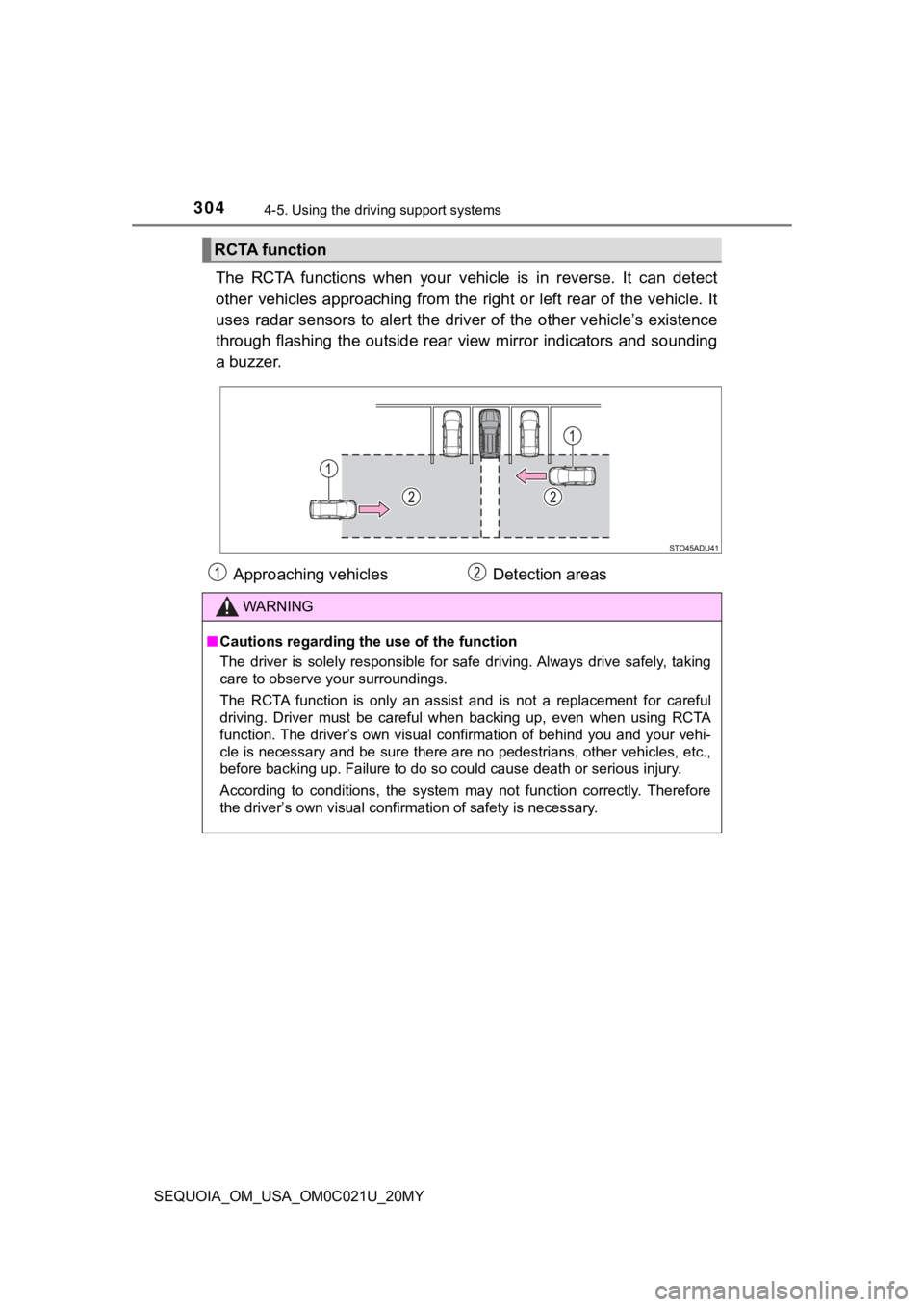
3044-5. Using the driving support systems
SEQUOIA_OM_USA_OM0C021U_20MY
The RCTA functions when your vehicle is in reverse. It can dete ct
other vehicles approaching from the right or left rear of the v ehicle. It
uses radar sensors to alert the driver of the other vehicle’s existence
through flashing the outside rear view mirror indicators and so unding
a buzzer.
RCTA function
Approaching vehicles Detection areas
WARNING
■Cautions regarding the use of the function
The driver is solely responsible for safe driving. Always drive safely, taking
care to observe your surroundings.
The RCTA function is only an assist and is not a replacement fo r careful
driving. Driver must be careful when backing up, even when usin g RCTA
function. The driver’s own visual confirmation of behind you an d your vehi-
cle is necessary and be sure there are no pedestrians, other ve hicles, etc.,
before backing up. Failure to do so could cause death or seriou s injury.
According to conditions, the system may not function correctly. Therefore
the driver’s own visual confirmation of safety is necessary.
Page 306 of 588
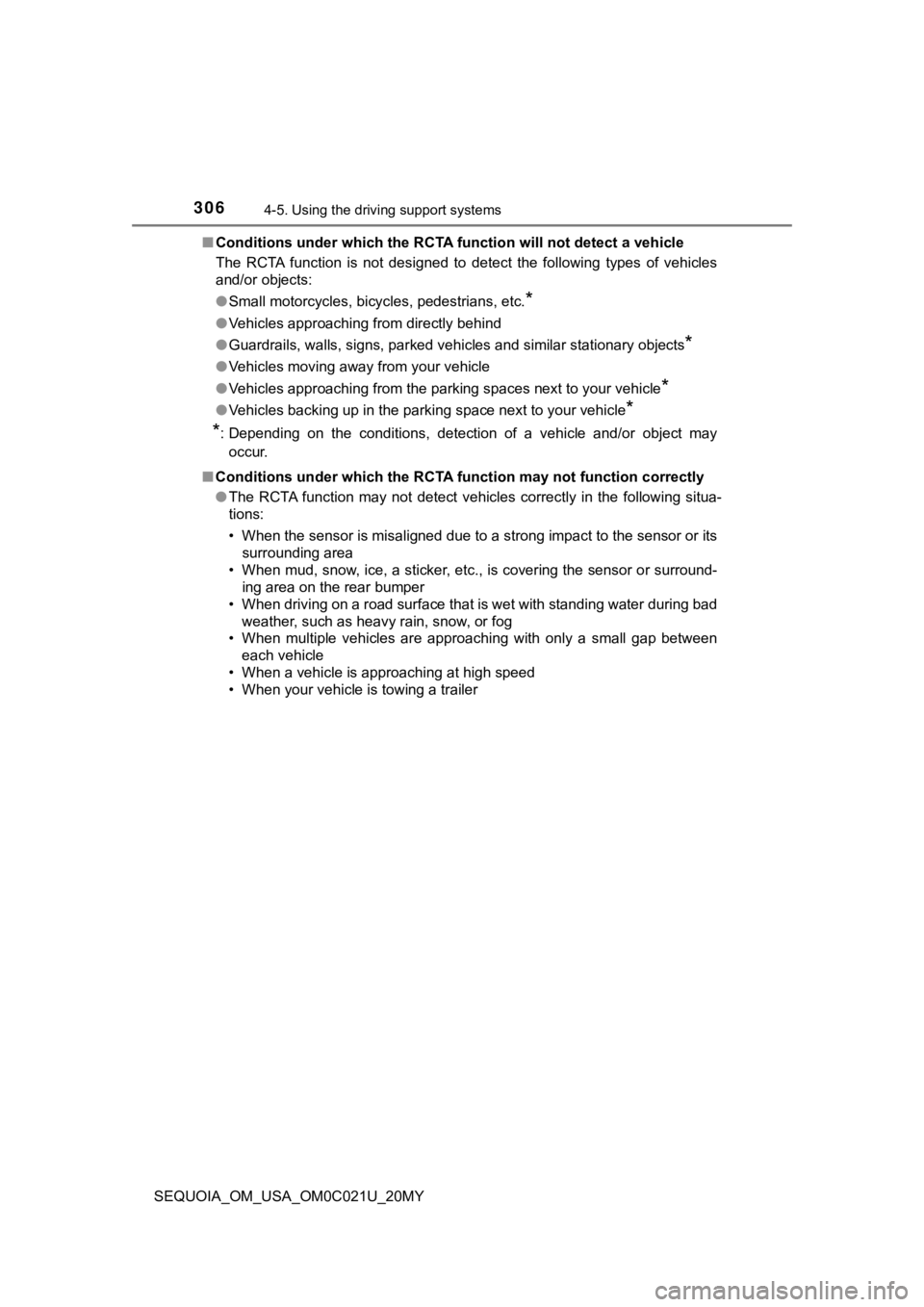
3064-5. Using the driving support systems
SEQUOIA_OM_USA_OM0C021U_20MY■
Conditions under which the RCTA function will not detect a vehicle
The RCTA function is not designed to detect the following types of vehicles
and/or objects:
● Small motorcycles, bicycles, pedestrians, etc.
*
●Vehicles approaching from directly behind
● Guardrails, walls, signs, parked vehicles and similar stationar y objects
*
●Vehicles moving away from your vehicle
● Vehicles approaching from the parking spaces next to your vehic le
*
●Vehicles backing up in the parking space next to your vehicle*
*
: Depending on the conditions, detection of a vehicle and/or obj ect may
occur.
■ Conditions under which the RCTA function may not function corre ctly
● The RCTA function may not detect vehicles correctly in the following situa-
tions:
• When the sensor is misaligned due to a strong impact to the se nsor or its
surrounding area
• When mud, snow, ice, a sticker, etc., is covering the sensor o r surround-
ing area on the rear bumper
• When driving on a road surface that is wet with standing water during bad
weather, such as heavy rain, snow, or fog
• When multiple vehicles are approaching with only a small gap b etween
each vehicle
• When a vehicle is approaching at high speed
• When your vehicle is towing a trailer
Page 307 of 588
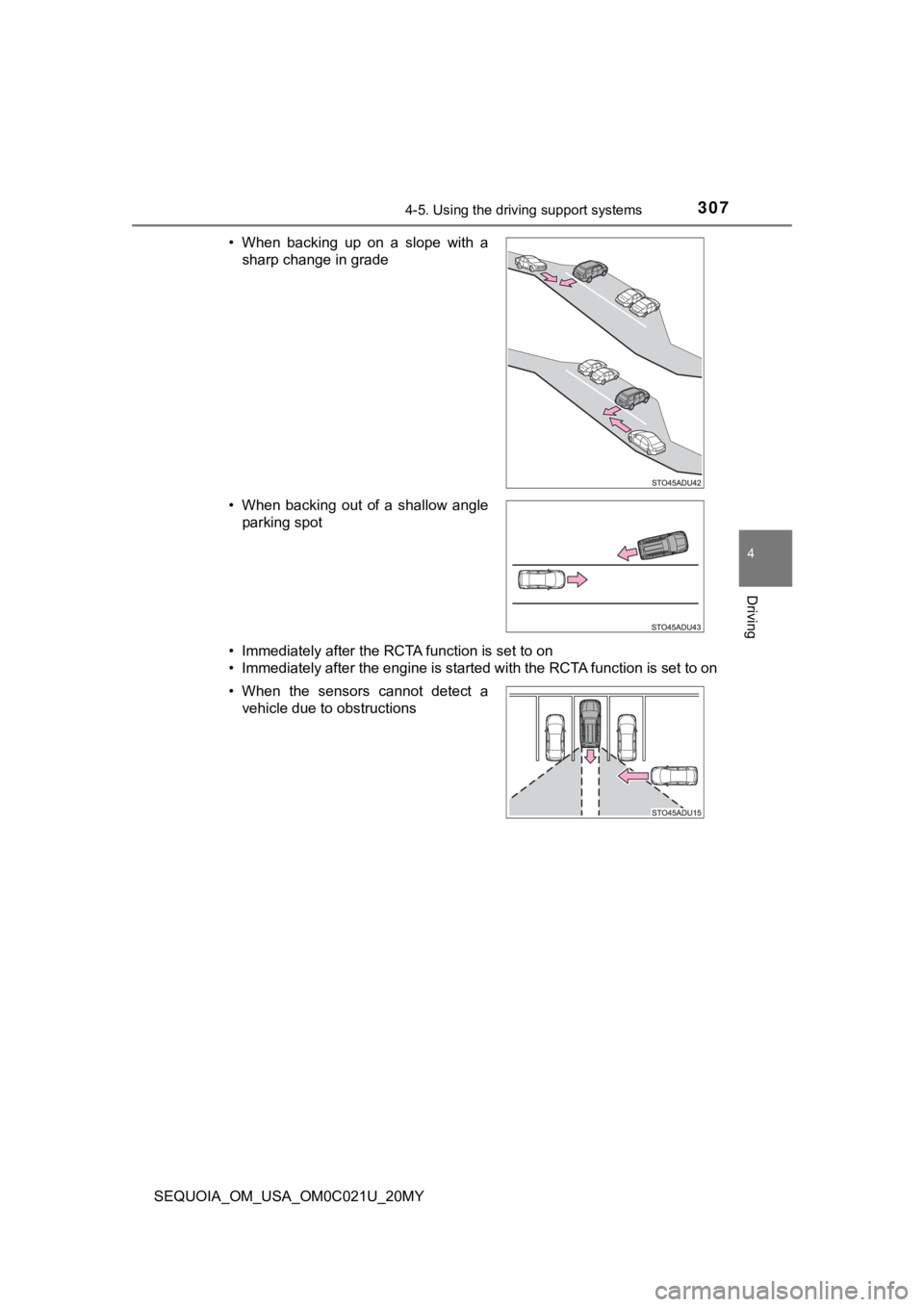
3074-5. Using the driving support systems
4
Driving
SEQUOIA_OM_USA_OM0C021U_20MY• Immediately after the RCTA function is set to on
• Immediately after the engine is started with the RCTA function
is set to on
• When backing up on a slope with a
sharp change in grade
• When backing out of a shallow angle parking spot
• When the sensors cannot detect a vehicle due to obstructions